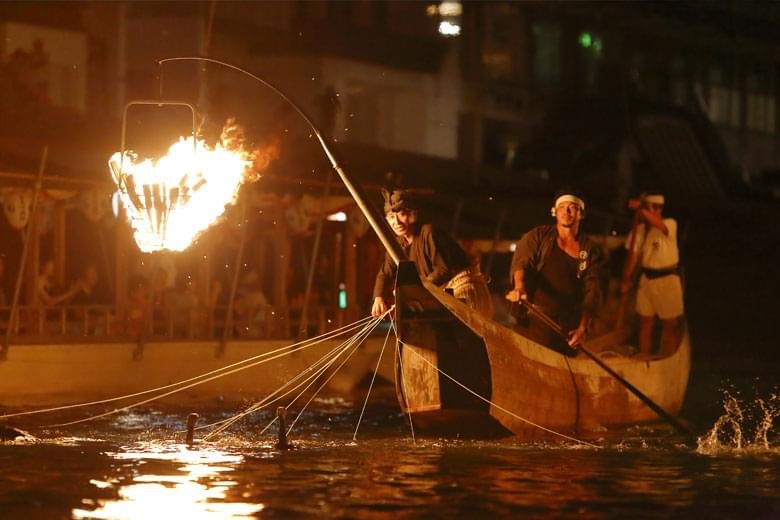
Ukai, or cormorant fishing, is a captivating and ancient Japanese tradition that dates back over 1,300 years. This unique fishing technique, practiced along several rivers in Japan, combines history, culture, and a deep connection to nature. The sight of skilled fishermen working with their trained cormorants against the backdrop of moonlit waters creates a spectacle that continues to draw both locals and tourists alike.
Ukai’s origins can be traced back to the Nara Period (710–794 AD), when it became a favored method of fishing among Japan’s aristocracy. Initially, cormorant fishing was not only a practical way to catch fish but also a form of entertainment for nobles and samurais. The art of cormorant fishing quickly spread to various parts of Japan, with the Nagara River in Gifu Prefecture becoming one of the most famous locations for this practice.
Throughout history, cormorant fishing has been closely linked with Japanese culture and spirituality. The cormorants, known as “ukai no u” in Japanese, are revered for their intelligence and agility. The practice has been passed down through generations, with fishermen, known as “usho,” dedicating their lives to mastering this art.
Fishing is traditionally performed at night during the summer months, from May to October. Fishermen use trained cormorants to catch river fish, particularly sweetfish, or “ayu,” which are prized for their delicate flavor. The fishermen control the cormorants with long ropes tied around their necks, allowing the birds to dive and catch fish while preventing them from swallowing their catch.
The process requires immense skill and coordination between the fisherman and his cormorants. The birds are trained from a young age, and a strong bond is formed between them and their handlers. This relationship is crucial for successful fishing, as the cormorants must trust and obey the fisherman to retrieve the fish without consuming them.
The sight of Fishing is nothing short of magical. As dusk falls, boats equipped with large braziers set out onto the river, the flames casting flickering light across the water. The cormorants dive and surface with astonishing speed, while the fishermen expertly guide them, creating a dance of man, bird, and nature that has remained unchanged for centuries.
Ukai is more than just a fishing method; it is a cultural heritage deeply embedded in Japanese tradition. Despite the challenges of modernization, ukai fishing has been preserved through the dedication of local communities and the support of the Japanese government. In fact, Ukai has been designated an Intangible Cultural Heritage by various municipalities, recognizing its cultural significance and the need to protect it for future generations.
The city of Gifu is particularly famous for its Fishing tradition, and every year, thousands of visitors flock to the Nagara River to witness this ancient practice. The Gifu Ukai Museum also plays a crucial role in educating the public about the history and techniques of Ukai, ensuring that the tradition is passed on to younger generations.
In addition to Gifu, Ukai is also practiced in other regions, including Seki, Uji, and Arashiyama. Each location offers a unique experience, with slight variations in the methods and traditions, but all share a deep respect for this ancient art.
While Ukai continues to attract interest, it faces several challenges in the modern era. The number of skilled fishermen is dwindling, as younger generations are less inclined to pursue this demanding and less lucrative profession. Moreover, environmental changes and pollution in Japan’s rivers have affected the availability of fish, making it harder to sustain the practice.
However, efforts are being made to ensure the survival of Ukai. Local governments and tourism organizations are working together to promote Fishing as a cultural attraction, offering tourists the opportunity to experience this unique aspect of Japanese heritage. In some areas, modern technology is being integrated into the practice, such as using lights to attract fish, helping to preserve the tradition while adapting to contemporary challenges.
Ukai also serves as an important reminder of the need for environmental conservation. The health of Japan’s rivers is crucial for the survival of this tradition, and efforts to clean and protect these waterways are essential. By maintaining the balance between tradition and modernity, Ukai can continue to be a living cultural heritage for generations to come.
For those interested in experiencing Ukai firsthand, several locations across Japan offer guided tours and demonstrations. The best time to witness Fishing is during the summer months, when the practice is in full swing. Visitors can board traditional boats and watch the fishermen and their cormorants in action, often followed by a meal featuring the freshly caught ayu fish.
Gifu’s Nagara River is one of the most popular destinations for Fishing, offering a combination of rich history, stunning natural beauty, and skilled practitioners who have perfected the art over generations. The city also hosts festivals and events centered around Ukai, providing a deeper insight into the cultural significance of this ancient practice.
Ukai, the Japanese art of cormorant fishing, is a testament to the enduring relationship between man and nature. This ancient tradition, steeped in history and cultural significance, continues to captivate those who witness it. As Japanese fishing communities work to preserve and adapt Fishing for the future, this remarkable practice serves as a living link to Japan’s past and a symbol of the country’s rich cultural heritage.
Source:
Washoku, the term for traditional Japanese cuisine, represents a profound aspect of Japan’s rich cultural…
BVE Train Simulator, often simply known as BVE, is a highly realistic train simulation game…
The Queen's Pawn Game, classified under the code D00 in the Encyclopedia of Chess Openings…
Shinjuku, a bustling district in Tokyo, is renowned for its vibrant nightlife, skyscrapers, and extensive…
Japanese fishing communities are redefining their economic future by tapping into the "sea industry," a…
Okinawa, the southernmost prefecture of Japan, is renowned for its rich history, vibrant culture, and…